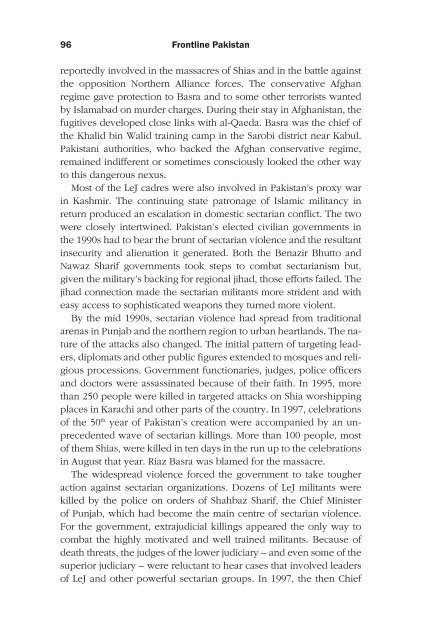Frontline Pakistan : The Struggle With Militant Islam - Arz-e-Pak
Frontline Pakistan : The Struggle With Militant Islam - Arz-e-Pak
Frontline Pakistan : The Struggle With Militant Islam - Arz-e-Pak
You also want an ePaper? Increase the reach of your titles
YUMPU automatically turns print PDFs into web optimized ePapers that Google loves.
<strong>Frontline</strong> <strong><strong>Pak</strong>istan</strong><br />
reportedly involved in the massacres of Shias and in the battle against<br />
the opposition Northern Alliance forces. <strong>The</strong> conservative Afghan<br />
regime gave protection to Basra and to some other terrorists wanted<br />
by <strong>Islam</strong>abad on murder charges. During their stay in Afghanistan, the<br />
fugitives developed close links with al-Qaeda. Basra was the chief of<br />
the Khalid bin Walid training camp in the Sarobi district near Kabul.<br />
<strong><strong>Pak</strong>istan</strong>i authorities, who backed the Afghan conservative regime,<br />
remained indifferent or sometimes consciously looked the other way<br />
to this dangerous nexus.<br />
Most of the LeJ cadres were also involved in <strong><strong>Pak</strong>istan</strong>’s proxy war<br />
in Kashmir. <strong>The</strong> continuing state patronage of <strong>Islam</strong>ic militancy in<br />
return produced an escalation in domestic sectarian conflict. <strong>The</strong> two<br />
were closely intertwined. <strong><strong>Pak</strong>istan</strong>’s elected civilian governments in<br />
the 1990s had to bear the brunt of sectarian violence and the resultant<br />
insecurity and alienation it generated. Both the Benazir Bhutto and<br />
Nawaz Sharif governments took steps to combat sectarianism but,<br />
given the military’s backing for regional jihad, those efforts failed. <strong>The</strong><br />
jihad connection made the sectarian militants more strident and with<br />
easy access to sophisticated weapons they turned more violent.<br />
By the mid 1990s, sectarian violence had spread from traditional<br />
arenas in Punjab and the northern region to urban heartlands. <strong>The</strong> nature<br />
of the attacks also changed. <strong>The</strong> initial pattern of targeting leaders,<br />
diplomats and other public figures extended to mosques and religious<br />
processions. Government functionaries, judges, police officers<br />
and doctors were assassinated because of their faith. In 1995, more<br />
than 250 people were killed in targeted attacks on Shia worshipping<br />
places in Karachi and other parts of the country. In 1997, celebrations<br />
of the 50 th year of <strong><strong>Pak</strong>istan</strong>’s creation were accompanied by an unprecedented<br />
wave of sectarian killings. More than 100 people, most<br />
of them Shias, were killed in ten days in the run up to the celebrations<br />
in August that year. Riaz Basra was blamed for the massacre.<br />
<strong>The</strong> widespread violence forced the government to take tougher<br />
action against sectarian organizations. Dozens of LeJ militants were<br />
killed by the police on orders of Shahbaz Sharif, the Chief Minister<br />
of Punjab, which had become the main centre of sectarian violence.<br />
For the government, extrajudicial killings appeared the only way to<br />
combat the highly motivated and well trained militants. Because of<br />
death threats, the judges of the lower judiciary – and even some of the<br />
superior judiciary – were reluctant to hear cases that involved leaders<br />
of LeJ and other powerful sectarian groups. In 1997, the then Chief













